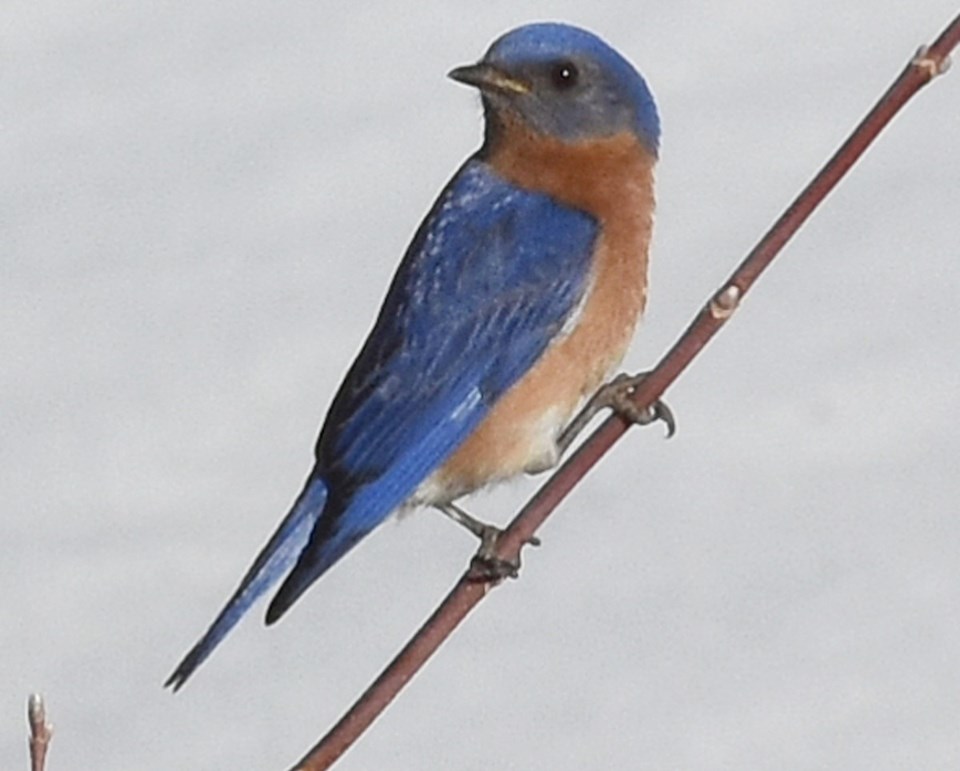"The early bird gets the worm." True, especially in June, but what if the early bird has arrived in an April snowstorm? Our recent spate of weather really put to the test the notion that "only fools rush in".
The spring migration of birds has been occurring in these parts of the country for a few thousand years, ever since the first shrubs and wildflowers returned after that bothersome glacier melted away. Where there was food and shelter the birds would find it. Our records of this annual migration go back in time only about 200 years, so it's hard to accurately extrapolate the earlier 11,800 spring arrival dates. What the data lacks in quantity we make up for with intensity, as the current methodologies for tracking bird flight is truly awesome.
Representatives of several species have been captured, banded, and outfitted with a wee backpack. Inside that backpack is a battery, an antenna, and a radio code. Built along the entire Atlantic migration route, from Florida to Ontario, are many receiving towers that will pick up the presence of these birds as they pass by. As tiny blips show up on massive computers, the movement of these birds can be monitored fairly closely. Arrival times at certain destinations can be forecasted within hours.
This tracking of the birds allows us to better understand migration routes and perhaps a bit of the "why" and "how" that these avian critters do to survive disruptive weather patterns. Do they sense impending doom and hunker down in Pennsylvania? Do they push onwards through the night to ride a warm thermal? Do they time their travel to meet emerging insects? Does the ice-out date of a certain lake trigger advancement?
All that aside, you and I know full well that it's not really spring until the first robin arrives and can be seen bob-bob-bobbing along in the yard. May not be the most scientific of ways to mark a new season, but seems to work for us anyways.
When that three-day snow-ice-slush storm hit in mid-April, several birds had already arrived, including robins, woodcock, killdeer, bluebirds, red-winged blackbirds, and Canada geese. These were the 'early birds', arguably the foolish ones that had rushed forward to lead the vernal migration. Oopsy... guess who got caught in the cold and snow?
Because each of these species has had several thousand springtimes to figure out this migration challenge, many have come up with survival strategies. Some retreat, some hunker down, and a few die thus eliminating the 'I'm going to get there first' trait of those adventuresome individuals.
The advance-retreat-advance method is noted with the waterfowl, the ducks, geese and swans that seek open water. Scouts are sent forward to determine which lakes are ice free... if they don't come back the next sortie is dispatched... if they don't come back it's time to move out and advance the flight!
The duck species that nest in the more northern parts of Ontario have an additional worry... can they get there soon enough to build a nest, lay eggs, raise young, and get out again before the next fall freeze-up? To ensure they don't get caught short with a late spring, they pair up, mate and begin egg development while en route. That way, as soon as they arrive, a nest can be thrown together and eggs laid immediately.
Robins and bluebirds are cousins within the thrush family, and share similar foods in their diet. Worms, bugs and other juicy things are preferred, but squishy fruit will do in a pinch. This is when all those fruit-bearing shrubs that you planted around your house come into play. Crabapples, highbush cranberries, nanneyberries and other soft fruits will be sought out by these birds.
Bluebirds will also do a group hug to stay warm on a chilly early spring night... there are many reports of a cluster of bluebirds found huddled inside a nesting box turned bird hostel.
Seed-eaters, such as fox sparrows and white-throated sparrows, will enjoy the late winter seeds at your feeder, jostling for position with the resident chickadees and blue jays. If they can find any natural seeds, so much the better.
The bird I'm most impressed with for spring hardiness is the woodcock. These long-beaked birds thrive on earthworms, yet when they first arrive to our farm such delicacies are below the snow and trapped by ground frost. I was fortunate to watch one the other day as it foraged between ice chunks and melting sections of our stream. It bobbed and wobbled (as woodcock do) and suddenly thrust its beak into the crusty mud. Success! A muddy and barely moving worm was extracted and gobbled down. After a few minutes the bird bob-wobbled again, and procured yet another worm. Amazing.
As weather watchers and birdwatchers combine their interests the results will hopefully reveal a few more secrets of the natural world that surrounds us. And what might the benefits be? Well, curiosity sated if nothing else. And maybe the changing behaviours of these early birds, these foolish birds, will carry a message to help us adapt to an ever-changing climate. After all, they've been working on it much longer than we have.
